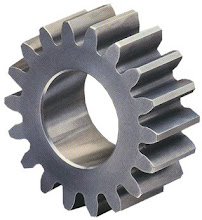How Gears Work
by Karim Nice
Inside this Article
Helical Gears
The teeth on helical gears are cut at an angle to the face of the gear. When two teeth on a helical gear system engage, the contact starts at one end of the tooth and gradually spreads as the gears rotate, until the two teeth are in full engagement. Photo courtesy Emerson Power Transmission Corp. Figure 3. Helical gears |
This gradual engagement makes helical gears operate much more smoothly and quietly than spur gears. For this reason, helical gears are used in almost all car transmissions.
Because of the angle of the teeth on helical gears, they create a thrust load on the gear when they mesh. Devices that use helical gears have bearings that can support this thrust load.
One interesting thing about helical gears is that if the angles of the gear teeth are correct, they can be mounted on perpendicular shafts, adjusting the rotation angle by 90 degrees.

Photo courtesy Emerson Power Transmission Corp.
Figure 4. Crossed helical gears


Tidak ada komentar:
Posting Komentar